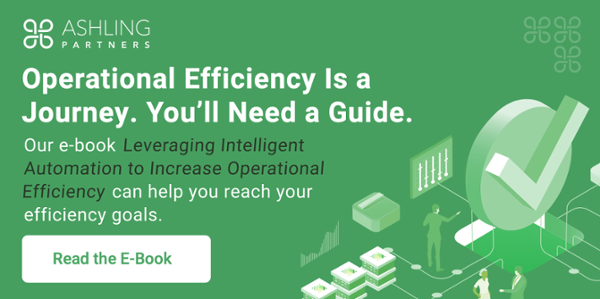Finance departments rely on multiple workflows to accomplish tasks. Many of these involve lots of documents and data. Most of this information is digitized, but that doesn’t mean there’s less manual work for these teams. Finance, just like every other line of business, must meet operational efficiency objectives. To achieve these goals, finance departments are relying more and more on a key component of operational efficiency: automation solutions.
In this article, we’ll look at what operational efficiency means to finance, the challenges the department faces, and how automation can solve these.
Operational Efficiency in Finance
Operational efficiency is the optimal use of time, people, technology, equipment, and inventory to meet the needs of a company or department. In the context of finance, it means streamlining processes and workflows, from processing invoices to analyzing spend.
To hit operational efficiency goals, you have to eliminate waste in any form. This is a challenging objective for finance because of the high volume of complex tasks. Let’s look at some obstacles that tend to prevent finance departments from achieving operational efficiency.
Challenges Finance Departments Face with Operational Efficiency
There are many challenges that create roadblocks on the way to operational efficiency in finance. Some are simple, whereas others are more complex. The primary ones include:
- Substantial manual work, which introduces errors and slows down throughput
- Multiple systems, some of which may be legacy, making interoperability difficult
- Copious amounts of data and documents to review
- Lots of dates to keep track of, including payments, contract renewals, and compliance filings
- Too much time and labor spent on repetitive tasks, which takes time away from workers to be analytical and strategic
These challenges, however, don’t have to hold you back any longer. When you deploy automation technologies, meeting operational efficiency goals is much more attainable.
How Automation Helps Finance Departments with Operational Efficiency
The adoption of automation in finance is high, with 80 percent of finance leaders using it in some form. This adoption rate strongly indicates that automation works to improve processes, reduce costs, and more. There are two types of automation you can use to address the above challenges.
- Robotic process automation (RPA): This is the base level of automation. It’s a software technology that enables the building, deployment, and management of digital bots. These bots can emulate simple human activities that are repetitive and standard, such as keystrokes, system navigation, identification and extraction of data, and other defined actions.
- Intelligent process automation (IPA): This automation category is the next step up and combines the capabilities of RPA with artificial intelligence (AI). It can involve several advanced technologies in the AI realm, such as computer vision, cognitive automation, and machine learning. IPA increases the value of automation and expands the possibilities of what you can do with it.
How can you use RPA and IPA in the financial field to drive operational efficiency?
Financial Automation Use Cases to Achieve Operational Efficiency
Applying automation to financial department workflows can impact many areas. Here are some examples.
Invoice and Payment Processing
You can shift this transactional work to software robots to eliminate errors, ensure data isn’t missing, and validate charges by matching them to purchase orders and speeding up the process. Not only does this process save considerable time and improve accuracy, but it also removes human workers from the process, allowing them to focus on things that truly need their attention.
Vendor Contract Management
Vendors may provide data in multiple systems, causing silos and disconnections. Automation can aggregate and centralize data, so you won’t miss payments and contract renewals.
Reconciliation
General ledgers are data-heavy and constantly changing. Reconciliation also requires much scrutiny. No matter how many human eyes view these ledgers, oversights still happen. Automation can minimize manual review and flag things that need further evaluation. According to Fiserv, automation can reduce the risk of reconciliation errors by as much as 50 percent.
Legacy and New Platform Integration
Automation is also key to getting all your systems to work together. Finance still depends on many legacy systems, which can stall digital transformation in some areas. Automation provides a better solution than increasing manual work or paying high costs to bridge compatibility.
Account Setup and Other Document-Heavy Tasks
Bots can extract data from screens and pull information from documents much more quickly and accurately than humans. This form of automation reduces the burden on your people and condenses these everyday routines into minutes.
Audit Trails and Transaction History
Having a record of everything is crucial in finance. Software robots can collect and integrate the data needed to streamline compliance activities, which also ensures you have documentation in the event of an audit.
Fraud Detection
It’s hard to catch fraud if you’re mired in manual processes. It may be months or years later when you find the first indication that something isn’t right. RPA keeps data clean and accurate. By further applying IPA, you can identify suspicious invoices, transactions, or payments.
Spend Analysis for Forecasting
Finance has mountains of data on all money coming in and going out. Careful analysis of this data can deliver impactful insights and identify trends. With this knowledge, you can forecast better and be more strategic. IPA provides this opportunity, helping finance departments improve cash flow and overall financial health.
Learn More About Operational Efficiency and Automation
These opportunities and the benefits they bring to your finance department can help you meet operational efficiency goals. Get more insights into automation by downloading our e-book Leveraging Intelligent Automation to Increase Operational Efficiency.



